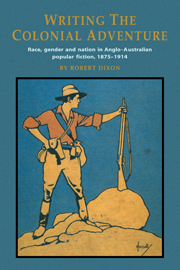 Writing the Colonial Adventure
Writing the Colonial Adventure Book contents
- Frontmatter
- Contents
- List of Illustrations
- Acknowledgements
- Introduction
- 1 The Romance of Property: Rolf Boldrewood and Walter Scott
- 2 Outlaws and Lawmakers: Boldrewood, Praed and the ethics of adventure
- 3 Israel in Egypt: The significance of Australian captivity narratives
- 4 Imperial Romance: King Solomon's Mines and Australian romance
- 5 The New Woman and the Coming Man: Gender and genre in the ‘lost-race’ romance
- 6 The Other World: Rosa Praed's occult fiction
- 7 The Boundaries of Civility: Australia, Asia and the Pacific
- 8 Imagined Invasions: The Lone Hand and narratives of Asiatic invasion
- 9 The Colonial City: Crime fiction and empire
- 10 Beyond Adventure: Louis Becke
- Conclusion
- Notes
- Select Bibliography
- Index
8 - Imagined Invasions: The Lone Hand and narratives of Asiatic invasion
Published online by Cambridge University Press: 05 November 2011
- Frontmatter
- Contents
- List of Illustrations
- Acknowledgements
- Introduction
- 1 The Romance of Property: Rolf Boldrewood and Walter Scott
- 2 Outlaws and Lawmakers: Boldrewood, Praed and the ethics of adventure
- 3 Israel in Egypt: The significance of Australian captivity narratives
- 4 Imperial Romance: King Solomon's Mines and Australian romance
- 5 The New Woman and the Coming Man: Gender and genre in the ‘lost-race’ romance
- 6 The Other World: Rosa Praed's occult fiction
- 7 The Boundaries of Civility: Australia, Asia and the Pacific
- 8 Imagined Invasions: The Lone Hand and narratives of Asiatic invasion
- 9 The Colonial City: Crime fiction and empire
- 10 Beyond Adventure: Louis Becke
- Conclusion
- Notes
- Select Bibliography
- Index
Summary
Despite the implications of the Lone Hand's cover illustration of February 1909 – in which the Northern Territory was represented as a blank – the paranoid responses to this ‘no man's land’ discussed in the previous chapter suggest that it was not a blank space at all, but a difficult site of discursive boundaries already inscribed by other, positive forces. The national self is constructed at its boundaries by the always ineffectual exclusion of its others, and nothing is more calculated to disclose the anxiety attendant upon that process than the invasion of boundaries. As Chandra Mohanty observes, ‘It is not the centre that determines the periphery, but the periphery that, in its boundedness, determines the centre’.
The present chapter deals with fiction of the first Commonwealth decade in which the new nation is invaded and its population emasculated by Asian powers. I am concerned not with the historical presence of Asian people in Australia's north, so much as the paranoia their presence produced in texts concerned with the construction of discursive boundaries. Alice Jardine has argued that paranoia about the loss of boundaries is a particularly masculine anxiety, and the Australian discourse on nation, as Kay Schaffer and others have shown, is a distinctively masculine construction. The texts of imagined invasion are paranoid, masculine texts in which those others, upon whose exclusion the myths of the new nation depend, contest the centre by breaching their boundedness.
- Type
- Chapter
- Information
- Writing the Colonial AdventureRace, Gender and Nation in Anglo-Australian Popular Fiction, 1875–1914, pp. 135 - 154Publisher: Cambridge University PressPrint publication year: 1995


